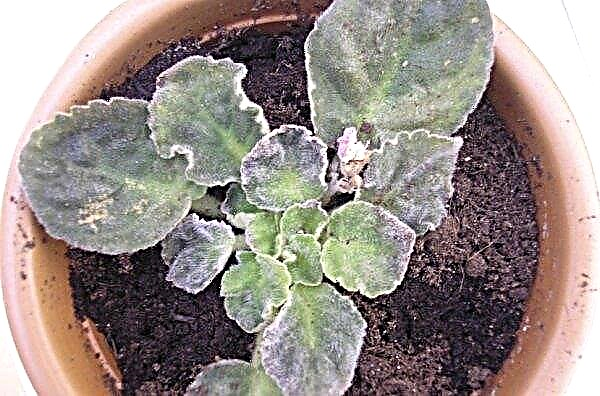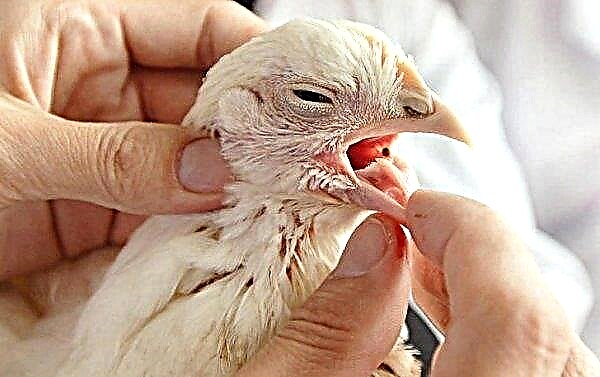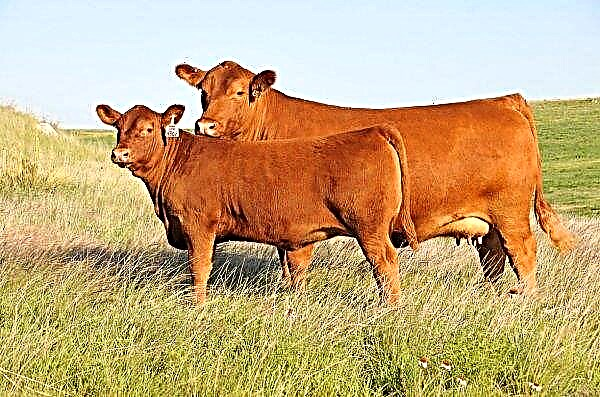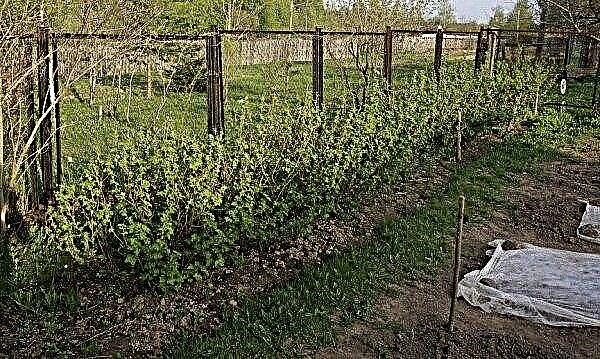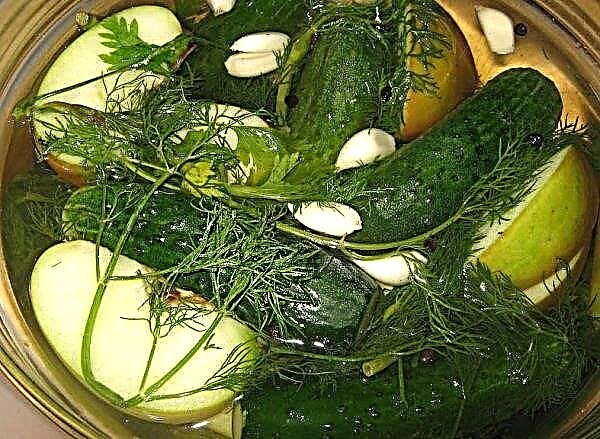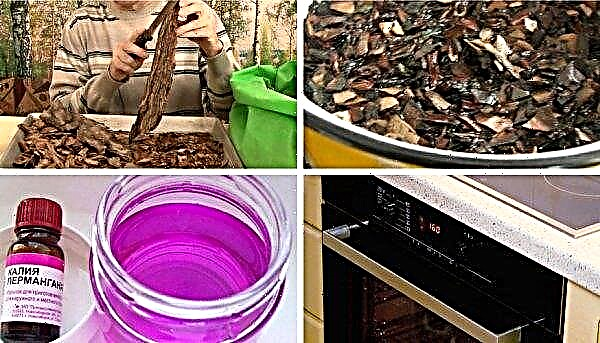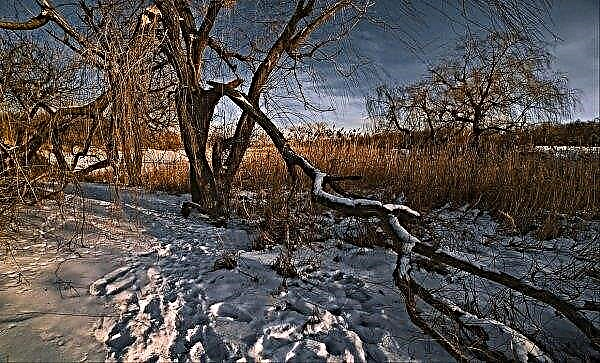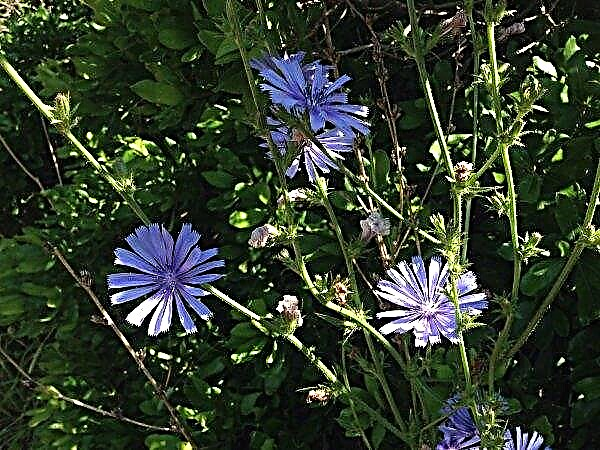Among the popular conifers in gardening, the species Juniperus sabina or Juniper Cossack stands out. The culture is unpretentious, easily adaptable to different conditions, therefore it is often used in landscaping parks and private gardens. Today in the article a detailed description and subtleties of cultivating Rockery Jam.
Botanical Description
A short open type of bush reaches a maximum of 0.8 m in height. The branches are thick, grow horizontally, the tips can be raised up. As they grow, they form a wide crown up to 2.5 m in diameter. The bark of a brown-red hue emphasizes the bright color of the short, prickly needles. Thin scaly needles have a blue-green color. The annual growth of the variety is only 2-3 cm in height, the crown grows by 20 cm per year.

At the age of 8 years, the shrub begins to bear fruit with cones. The size of the fruit is not more than 0.7 cm, on the branches they are almost invisible. The color of the mature cones is dark blue. Flake seeds ripen throughout the year.
Important! When planting a species of Juniper Cossack, it should be noted that the essential oil in its composition is poisonous. For pets, the plant can be dangerous.
Growing conditions
Despite the unpretentiousness of the Rockery Jem variety, some subtleties will help the gardener achieve the greatest decorativeness.
Criteria for successful cultivation:
- Landing - in the spring before the movement of juices, in the fall before frosts, ideally in early September.
- The soil - friable, sandy loam or loamy, moderately fertile. The reaction is neutral or slightly acidic in the range of 4–7 pH.
- Lighting - scattered. Light shading from direct sunlight is best suited. If there is a strong shadow, the bush will be loose.
- Humidity - moderate. Groundwater location - at least 2 m from the surface of the earth. Likes frequent spraying of the crown.
- Neighbors - low annual and perennial plants. The distance between cultures is at least 2 m, given the spreading crown.
- Wintering - First-year seedlings require sheltering soil and branches.
Video: Juniper Cossack Rockery Jam
You should know that the plant holds the soil perfectly, so it is often used in difficult areas: slopes, hillocks or slopes.
Landing
Seedlings are best purchased in a nursery, where, firstly, you can get high-quality material, and secondly, get recommendations for care. It is advisable to acquire specimens with a closed root system - such plants are better rooted. For 3-4 weeks, the soil at the planting site should be prepared. They dig it up, if necessary, deoxidize, adding 200-400 g of wood ash per m². As a fertilizer, peat 2-3 kg per m² is embedded in the soil.
Important! Juniper Cossack, according to the description, is a carrier of such a disease as rust. Planting it next to fruit crops is not recommended.
Landing technology:
- The size of the pit is twice the size of the root coma.
- At the bottom put drainage with a layer of 10-15 cm from expanded clay or other improvised material.
- A hill up to 20 cm high is poured on top.
- The seedling is placed on the embankment, spread the roots and sprinkle with soil.
- The earth needs to be tamped, except for pockets with air.
- The seedling growth point should be 5–7 cm higher above the surface.
- After planting, watering is carried out and mulched, but not in a thick layer, so as not to close the root neck.

Juniper Care
It’s easy to take care of the culture. In the absence of natural precipitation, the soil needs to be moistened 2-3 times a month. At other times, 3-4 times per season. In the heat, it is recommended to spray the needles. Do this in the morning or in the evening, every 10 days. If you carry out the procedure during the day, green needles will get burned during the evaporation of moisture.
Did you know? In Ancient Russia, dishes were made from juniper to store fresh products, it is noteworthy that even on the hottest day milk was not sour in such containers.
After watering, the soil around the trunk is loosened and weeds are removed.. To keep moisture in the soil longer, the trunk circle is mulched with wood bark or sawdust.
In the spring, fertilizer, for example nitroammophoska. Granules are scattered in a dry form up to 50 g per m², close up in the soil. It’s not worth zealous to fertilize coniferous crops: one more can be carried out in mid-summer with the same composition.
Video: How to properly care for juniper
Cropping and shaping the crown
Rockery jam quickly builds up the crown, therefore periodically needs pruning. The formation of the bush is carried out on the 5th year of life, gradually. The total procedure should not be carried out so as not to weaken the bush. Since the variety grows in breadth, the upper branches can be trimmed once every 5–7 years. Lateral shoots are pruned more often to shape the crown. In the spring you need to inspect the bush and remove weak and broken branches. If the bush is weakened, but it needs to be thinned out, apply the method of pinching the tops.

Use in landscape design
In the description, the variety Rockery Jam is presented as a dwarf bush, on average its height is up to 0.5 m. Such crops look good in the form of a green border, along the edge of an artificial reservoir or as a solo on a lawn.
The ability to grow on problematic soils is used to smooth out surface drops in the garden, to hide unsightly areas. The fact that with the growth of the lower shoots spread on the ground, you can use it to create the effect of multi-level plantings in a mixed design style.
Did you know? The berries of some varieties of juniper are used as a natural seasoning for meat. The fruit gives an unusual taste to pickles and marinades, as well as various drinks.
Shrub can be combined with groundcover and flowering plants:
- periwinkle;
- hoof;
- meadow bluegrass;
- saxifrage;
- stonecrop;
- stalk.
The blue-green needles of a short bush look great in the center of a flower bed.
Rockery Jam looks good in plantings with other coniferous and deciduous shrubs:
- barberry;
- spirea;
- thuja;
- dwarf Tsuga.

Ornamental coniferous shrubs are a great idea for landscaping. Juniper is not demanding in care and easily adapts to the proposed conditions.


